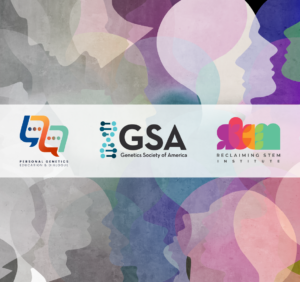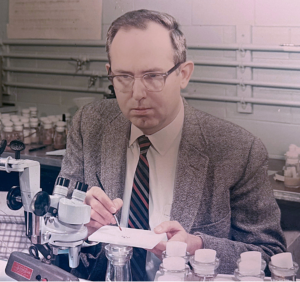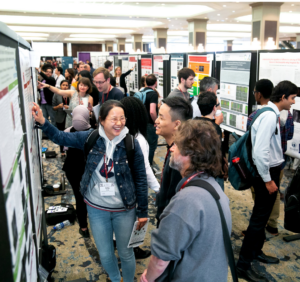Our latest blog series shedding light on how members of our community are being affected by recent government funding and policy changes continues with a look into the economic impact to the United States and loss of output from decreased investment in science. Read the previous post on how the changes are impacting early career scientists and closing the door on the American Dream for many here.
Scientific research is one of the most powerful drivers of the U.S. economy, and with every dollar invested, there’s a return of $2.461. It fuels innovation, seeds new industries, trains the future workforce, and brings solutions to urgent challenges—from public health crises to climate change.
In recent years, federal investment in research and development (R&D) has failed to keep pace with inflation, scientific need, and international competitors. Now, a new budget proposal calls for even deeper cuts. Key areas such as cancer research, rare disease studies, and mental health treatment face devastating shortfalls. The National Academies have warned that such “staggering” cuts would force the closure of entire research centers and significantly shrink the U.S. scientific workforce2.
The long-term effects of such disinvestment aren’t just theoretical, they’re already unfolding in real time.
One GSA member, now leading a science start-up, describes the reality from the front lines: “Anyone laboring under the illusion that government science grant cuts won’t affect the economic growth of the U.S. is sorely mistaken.”
Though no longer in academia, this CEO represents the increasingly common path from graduate school to entrepreneurship—a transition made possible by a pipeline of publicly funded research and training. Start-ups like theirs depend on early-stage public investment to de-risk their technologies, many of which originated in university labs supported by National Institutes of Health, National Science Foundation, and USDA grants. “Government is the primary mechanism that start-ups use to secure early funding,” they explained. “Outside of government, very few alternative funding sources exist for early-stage companies that require R&D work. And now, those public sources are vanishing.”
Federal funding cuts freeze the entire innovation economy
Consider this: a 2023 report by the Information Technology and Innovation Foundation found that a $1.00 increase in publicly funded basic research stimulates an additional $8.38 of industry research and development investment after 8 years. Start-ups spun out of academic labs, new drug discoveries, agricultural innovations, and clean energy technologies are all downstream of basic science.
When funding disappears, it isn’t just university researchers who are affected—it’s the entire national ecosystem. “In my company, we’ve seriously been discussing seeking funding outside the U.S. Not because we want to, but because domestic public funding has all but disappeared,” the CEO said. “There simply are no funds to support early-stage science start-ups in the US anymore.” This loss will create a void of American jobs, industries, and intellectual property.
What makes this situation even more concerning is the waste involved. The U.S. government already invests heavily in training scientists, yet without continued research funding, those highly-trained individuals are being pushed out of the system. “Every unemployed scientist, every scientist who leaves the U.S. to work elsewhere, is our government throwing away $500k a pop,” the CEO said. “It’s been heart-wrenching to see my friends and colleagues unemployed. It’s been unimaginably stressful to see future career opportunities in science vanish.”
Compounding impact
When the U.S. loses scientists, it doesn’t just lose their discoveries—it loses future mentors, educators, and founders. It erodes public trust in science careers and discourages the next generation from entering the field. And these changes undermine long-term national competitiveness at a time when other countries like China are dramatically increasing their R&D investments.
The National Academies have been sounding the alarm for years. Their response to the Trump-era budget proposal in 2017 noted that slashing federal science funding would “set us back generations.”
Cutting science funding to save money is not a smart economic move. It sacrifices long-term prosperity for short-term savings—a choice that threatens both public health and economic security. A member of the scientific community describes it as, “cutting science funding to save money is like drinking arsenic to cure brain cancer—not only will it not work, it’ll kill you faster.”
If the U.S. wants to remain a global leader in innovation and reap the economic rewards of its scientific investments, it must recommit to sustained, predictable funding for research. Science isn’t a cost, it’s capital—and without it, economic advancement grinds to a halt.
At the end of the day, these policy changes are leading to a decreased prioritization of U.S. advancement in science and public health. We will continue to see a vicious cycle of economic loss, decreases in the young workforce, loss of global standing for the U.S. with regard to research and development, and fewer investments in the scientific enterprise and workforce. As we continue to collect stories from community members trying to navigate these new policy changes, we are dedicated to sharing them and continuing to build community and a safe space to share your concerns in future blog posts.
We urge you to continue to call your elected officials and share the short-term and large-scale effects of these government decisions. If you have been impacted by these issues and would be willing to share your experience anonymously, we’d like to hear from you. Your voice matters. Submit your story through this private form.
- “Direct Economic Contributions”, National Institutes of Health, April 18, 2025, www.nih.gov/about-nih/impact-nih-research/serving-society/direct-economic-contributions. ↩︎
- Meredith Wadman, “National Academies, Staggering from Trump cuts, on brink of dramatic downsizing”, Science.org, June 2, 2025, www.science.org/content/article/national-academies-staggering-trump-cuts-brink-dramatic-downsizing. ↩︎































